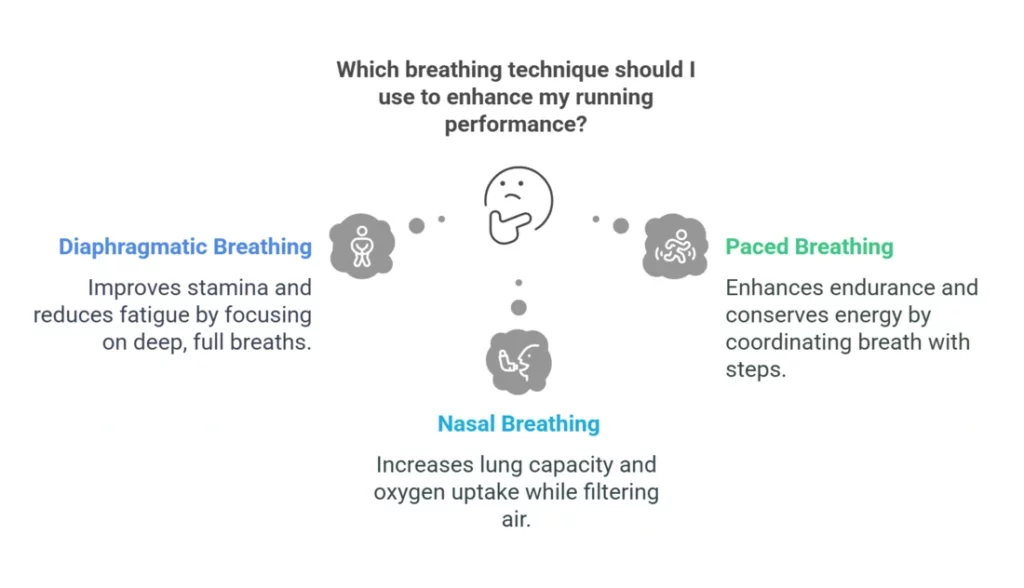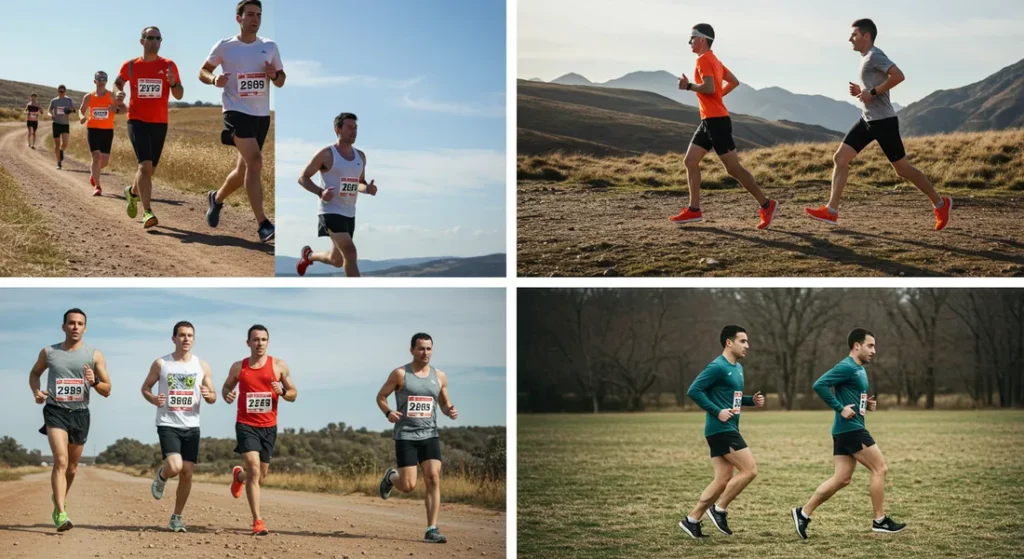Are you pushing your limits on the track or trail, but still struggling to find a comfortable rhythm?
You might be surprised to learn that your breathing can make or break your run, and that without focusing on the best methods, you may be limiting your true athletic potential.
This is why understanding breathing techniques for running is incredibly important for anyone looking to enhance their performance, and also to improve their overall endurance.

In this complete guide, I’ll provide you with a full overview of what you need to know to master your breath, and also to transform your runs.
Why Proper Breathing Matters For Runners
Before we explore specific techniques, it is important to first understand why proper breathing is so essential for runners.
Breathing isn’t simply about taking in air; it’s a crucial element of your overall performance that can influence your stamina, endurance, and also your recovery time.

Key Points
- Link Between Breathing and Running Performance:
- Proper breathing ensures that your muscles are receiving a consistent supply of oxygen, which is the fuel they need to perform at their best. Without this, your muscles will struggle to operate at their optimum, and also you may experience a rapid decline in performance.
- When you are breathing correctly, you are ensuring that your body is able to get the most out of every single workout.
- Negative Effects of Poor Breathing During Runs:
- When you breathe incorrectly during a run, you are limiting your body’s ability to deliver oxygen. This results in rapid fatigue, shortness of breath and also muscle tension which will drastically affect your performance.
- If you do not focus on your breathing, you are also more likely to experience the dreaded side stitches which can make running incredibly difficult.
Understanding Key Breathing Techniques For Running

Now that you know why proper breathing is so essential for runners, let’s dive into the specific breathing techniques that can help you enhance your overall performance.
Each method offers unique benefits and can be used to improve your fitness journey.
Breathing Technique Summary
| Technique | How to Implement | Key Benefits For Running |
| Diaphragmatic Breathing | Focus on deep breaths, and also allow your belly to rise with each inhale. | Helps to improve your overall stamina and also to reduce fatigue. |
| Paced Breathing | Coordinate your breathing with your movements, such as inhaling for four steps, and exhaling for four steps. | Helps to improve your overall endurance, and to conserve your energy. |
| Nasal Breathing | Breathe exclusively through your nose, while also focusing on the air filtering through your nasal passages. | Helps to provide a clean and warm supply of oxygen, whilst also improving lung capacity, and the uptake of nitric oxide. |
Detailed Explanations of Each Technique:
- Diaphragmatic Breathing:
- Explanation: Diaphragmatic breathing, also known as belly breathing, involves breathing deeply, using your diaphragm, which is the large muscle at the base of your lungs. This allows you to take a full breath, which is essential for proper lung function.
- How to do it:
- Start by finding a comfortable position. You can lie down or stand up, depending on your preference.
- Place one hand on your chest and one hand on your belly.
- Inhale slowly through your nose and allow your belly to rise, while also trying to keep your chest as still as possible.
- Exhale slowly and completely through your mouth.
- Repeat this method several times.
- Benefits for Runners: “By implementing belly breathing into your routine, you will find that your stamina will improve, your feelings of fatigue will reduce, and you will also be making your breaths more efficient overall.”
- Paced Breathing:
- Explanation: Paced breathing, also referred to as rhythmic breathing, involves coordinating your breathing with your steps. This will help you to create a consistent rhythm, and to also better manage your energy while running.
- How to Implement: As you run, you will be counting your steps. You could start by inhaling for three steps, and exhaling for three steps, and then you should adjust your technique as your body feels fit. It is all about finding the rhythm that works best for you.
- Benefits for Runners: Paced breathing will help you to conserve your energy and also to improve your overall endurance. By using this method you are ensuring that you are getting the most out of your breath, and that your body is in sync with your movements.
- Nasal Breathing:
- Explanation: Nasal breathing involves inhaling and exhaling exclusively through your nose, which helps to bypass the mouth and to also take advantage of your body’s natural filtration system.
- How to Implement: When running, simply focus on keeping your mouth closed, and only breathing through your nose. If this feels challenging at first, simply begin slowly and work your way up.
- Benefits for Runners: Nasal breathing will help you to filter the air you are breathing, which will reduce impurities, allergens, and pollutants from entering your lungs. You will also benefit from increased oxygen absorption and also the natural production of nitric oxide, which is a key component for athletes.
Studies have found that nasal breathing significantly improves oxygen utilization during exercise, and also reduces feelings of breathlessness and fatigue [https://pmc.ncbi.nlm.nih.gov/articles/PMC5466403/]. This is what makes it so beneficial for athletes.
Tailoring Breathing Techniques to Different Types of Runs
Now that you have a good understanding of various breathing techniques, it’s important to understand that not all runs are the same, and it is best to implement a range of methods into your routine to best suit your individual needs.
Here’s how to tailor your breathing approach to maximize your performance for different types of runs.

Key Strategies
- Long-Distance Running:
- For long-distance runs, focus on maintaining a consistent rhythm with your breath and try to use paced breathing as your main method. This technique will allow you to conserve energy and also to avoid any feelings of breathlessness as you embark on longer runs.
- You should also incorporate belly breathing throughout the activity, to allow you to get as much oxygen as possible to your muscles, whilst also promoting relaxation, and reducing tension.
- Uphill Running:
- When running uphill, you will need to adapt your technique to ensure that you are breathing correctly, as you will likely experience breathlessness and a rapid heart rate. Try using deeper breaths and focus on rhythmic breathing to help to maintain your pace. Try using shorter bursts of effort, rather than trying to push yourself too far at once.
- It is important to understand that breathing uphill is different, and that you need to adapt to suit your environment.
- Speed Training:
- During speed training, you will need to focus more on breath control and to make sure that your diaphragm is strong and able to meet the demand. Ensure you are engaging in proper training and using your breath as a powerful tool to help you to push yourself further.
- During these intense training sessions, you will likely find that your breath increases. Therefore you should also focus on mindful awareness to ensure that you are not over breathing, and that your body is performing to its optimum.
- Recovery Runs:
- On recovery runs, the focus should be on relaxation and also muscle repair. This is where techniques such as diaphragmatic breathing and also breath awareness are incredibly useful to promote relaxation and to give your body what it needs to recover effectively.
- By focusing on breathing, you are ensuring that your body is in a state of rest, and therefore you are allowing your muscles to heal and repair themselves more quickly.
Common Breathing Mistakes That Runners Make
Even seasoned runners often fall into common breathing traps that can hinder their performance.
By understanding these mistakes and how to fix them, you’ll be well on your way to breathing more efficiently during every single run.”
Key Mistakes
- Shallow Breathing:
- Explanation: Shallow breathing, often a result of overexertion, occurs when you take short, rapid breaths that don’t fully engage your lungs. This means that you are taking in less oxygen, and that you are also failing to expel all of the waste products from your body. This common error will quickly limit your stamina, and leave you feeling tired and breathless.
- How to Fix It: To combat shallow breathing, focus on taking deep, deliberate breaths that engage your diaphragm. You can also implement techniques such as diaphragmatic breathing to help you to increase your lung capacity, and to ensure your body is getting what it needs.
- Holding Your Breath:
- Explanation: Holding your breath is another common mistake, and is often caused by pushing yourself too far or by performing movements that you are not familiar with. Holding your breath, also known as the Valsalva maneuver, prevents oxygen from reaching your muscles, which can cause muscle tension and lead to fatigue.
- How to Fix It: The best way to avoid holding your breath is to focus on mindful breathing and to take consistent breaths. By becoming more aware of the rhythm of your breath, you will be able to identify when you are holding it, and also actively prevent it. This is a key method that you should be implementing in all workouts.
- Mouth Breathing:
- Explanation: As we have discussed earlier, mouth breathing is another habit that you should be looking to eliminate during your workouts, as it bypasses your nasal passages, which provide a number of key functions. By breathing through your mouth, you are reducing the amount of oxygen that your body receives, and also leaving yourself vulnerable to infections.
- How to Fix It: It’s best to try and focus on nasal breathing as much as possible. To help with this, try closing your mouth and focusing on breathing through your nose. This will take time and practice, but it will provide many long term benefits to your overall health.
Tips For Implementing Proper Breathing Techniques
Making lasting changes to your breathing habits takes time and practice.
To ensure that you are able to implement proper breathing techniques into your workouts, here are some practical tips that will help you on your journey.
Key Tips
- Start Slowly:
- When beginning your journey into breathing techniques, be sure to start with small, manageable steps. It’s best to focus on one breathing method at a time, and not to overwhelm yourself with too many changes at once.
- By starting slowly, you are ensuring that your body is able to adjust, and also that it is easier to implement these techniques into your overall routine.
- Be Consistent:
- Consistency is key to mastering any new technique, so try to practice your breathing techniques during each workout. This will help to create the necessary muscle memory to make it second nature.
- Over time, you will find that your body will automatically adapt to these new methods, and that you will also notice some amazing benefits.
- Monitor Your Progress:
- Try to be mindful of how your body feels, and also to track your progress over time. Ask yourself what are you noticing after you implement new breathing techniques? Do you feel more or less tired? Do you feel more or less focused? These questions will help you to monitor your body’s response.
- By tracking your results, you will also understand how your body is reacting to these new methods, and you will be able to make adjustments as needed.
- Adjust Where Necessary:
- Remember that you are in control of your fitness journey, and that it is vital to always do what feels best for you. You can always adapt your methods and routines to suit your individual needs, so that you are comfortable and are also achieving results.
- What works for one person, might not always work for you, so you will need to explore all options until you find something that fits.
Frequently Asked Questions About Breathing for Running
To ensure that you have all of the answers you need, and to also further enhance your understanding of the key components of proper breathing, here are some frequently asked questions about breathing for running.
These have been created with a variety of sources, and are focused on providing you with real, actionable answers.
- Question 1: Should I breathe through my nose or mouth while running?
- Answer: While it is often tempting to breathe through your mouth to increase your oxygen intake, it is always best to focus on breathing through your nose. Nasal breathing is a natural method of breathing that helps to filter and humidify the air, and it is also important for the production of nitric oxide, which enhances blood flow. Mouth breathing should be avoided where possible, as it bypasses these important processes.
- Question 2: How can I improve my stamina when running?
- Answer: To improve your stamina when running, you should focus on practicing consistent paced breathing. This is a simple method that allows you to coordinate your breath with your movements, which in turn helps to conserve your energy, and improve your ability to maintain a steady pace. By using paced breathing regularly, you are providing your body with what it needs to push yourself further, for longer.
- Question 3: What is the best breathing pattern for running?
- Answer: “The best breathing pattern for running will vary from person to person. However, a common approach is to use rhythmic breathing where you focus on using the same number of breaths for both your inhale and your exhale. Try to begin with an equal breath count, and then adjust it as your body sees fit. You can use a ratio like 3:3 or 4:4 and see which works best for you. Always remember that you are in control of your journey.”
- Question 4: When is mouth breathing okay while running?
- Answer: While nasal breathing is the most optimal method for the majority of runs, mouth breathing is not always something to be avoided. It is understandable that you may need to breathe through your mouth during intense moments, or uphill running. If you notice that you are mouth breathing, and you are pushing yourself to the limit, take a pause, and when you can, ensure you are focusing back on nasal breathing, to get the most out of your performance.
Final Thoughts on Breathing Techniques for Running
As we reach the end of this comprehensive guide, I hope you now have a solid understanding of how breathing techniques can elevate your running journey.
By making conscious changes to the way that you breathe, you are taking control of your workouts, and taking action towards a better fitness journey.
We’ve covered key topics, from the importance of proper breathing for runners, to specific techniques such as diaphragmatic breathing, paced breathing, and nasal breathing.
By now, you should understand how to implement these methods, and you will also be aware of how to tailor them to different types of runs.
The most important thing is to experiment, and also to find what works best for you, so that you can truly maximize your performance.
I encourage you to begin implementing these breathing methods on your next run and to fully embrace the journey of mindful breathing.
I also want you to remember to be patient with yourself and to take each step at a time.
You are on the right path, and I can’t wait for you to experience the difference that proper breathing can make for your fitness journey.
Now, go forth and breathe!
Related Posts
No posts
